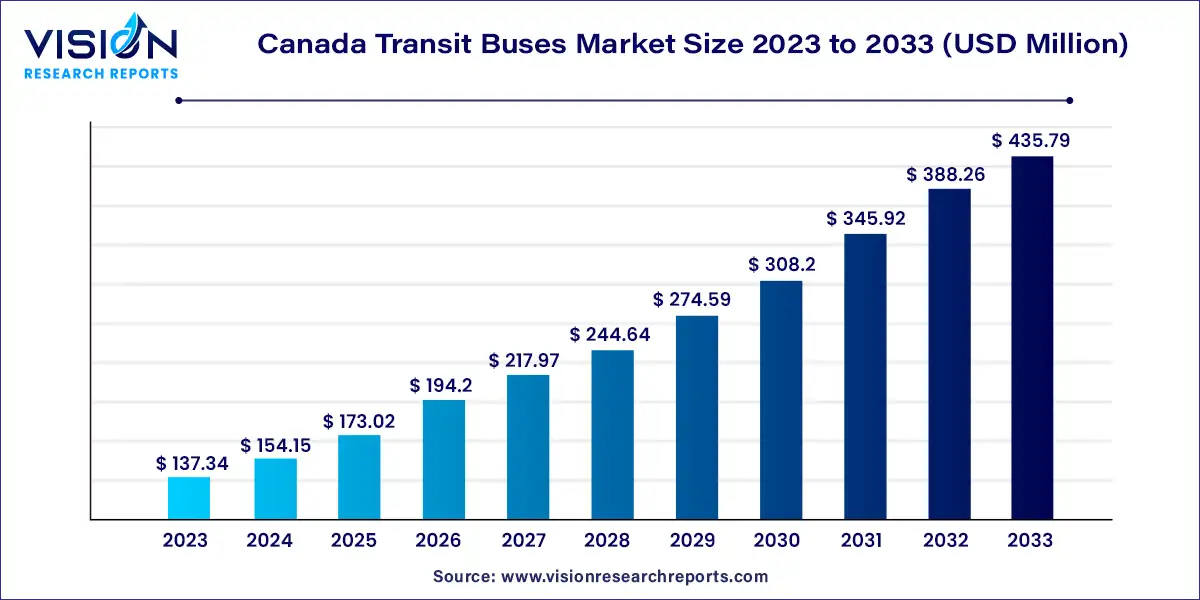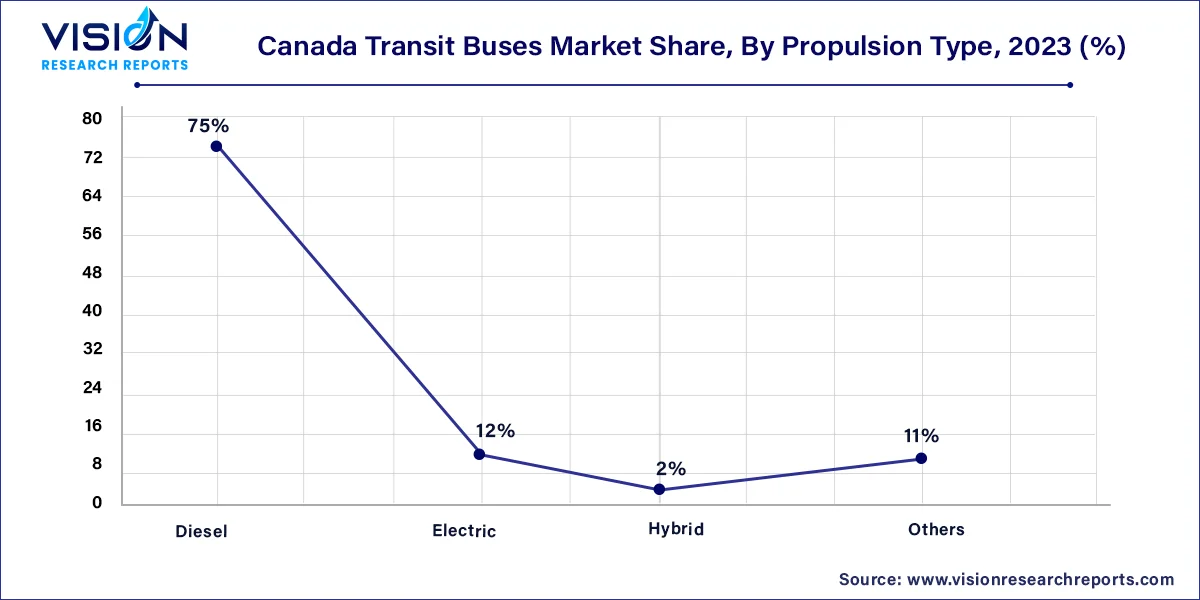The Canada transit buses market was size valued at USD 137.34 million in 2023 and it is predicted to surpass around USD 435.79 million by 2033 with a CAGR of 12.24% from 2024 to 2033.

The transit bus market in Canada stands as a vital component of the country's public transportation infrastructure. With a focus on efficiency, sustainability, and passenger comfort, the sector plays a crucial role in facilitating urban mobility and reducing environmental impact.
The growth of the transit bus market in Canada is driven by the population growth and urbanization have led to increased demand for efficient and sustainable transportation solutions, spurring investments in public transit infrastructure. Additionally, government initiatives aimed at improving accessibility, reducing traffic congestion, and mitigating environmental impact have bolstered the growth of the transit bus market. Moreover, advancements in technology, such as the adoption of electric propulsion systems and hybrid engines, have enhanced the efficiency and eco-friendliness of transit buses, further fueling market expansion. Furthermore, rising awareness of environmental issues and the importance of sustainable mobility solutions have prompted transit agencies and operators to prioritize the adoption of greener transportation alternatives.
| Report Coverage | Details |
| Market Size in 2023 | USD 137.34 million |
| Revenue Forecast by 2033 | USD 435.79 million |
| Growth rate from 2024 to 2033 | CAGR of 12.24% |
| Base Year | 2023 |
| Forecast Period | 2024 to 2033 |
| Market Analysis (Terms Used) | Value (US$ Million/Billion) or (Volume/Units) |
Based on propulsion type, the diesel segment accounted for the largest share of over 75% in the Canada transit buses market in 2023. The segment’s growth can be attributed to the lower operating costs of diesel-powered buses. Also, several key players in Canada are investing aggressively in research and development to develop innovative, low-emission solutions that can potentially lower the volumes of nitrous oxide and particulate emissions from diesel engines. Moreover, the transition to electric fleets still requires a robust electric ecosystem that covers all the aspects of the bus, from installation of the components to maintenance and wear and tear of the vehicles.

The electric segment is expected to expand at the fastest CAGR over the forecast period. The continued electrification of public fleets and the aggressive adoption of electric transit buses by public fleet operators in Canada is projected to offer growth prospects for the Canadian transit bus market. Several companies have also emphasized investing in the electric transit business, which is expected to further support the growth of the electric segment and the overall transit bus space in Canada. For instance, in August 2023, Alexander Dennis Ltd., a subsidiary of NFI Group, announced the launch of new electric bus solutions entirely developed and integrated in-house with its expertise, expanding its portfolio of zero-emission buses.
By Propulsion Type
Chapter 1. Introduction
1.1. Research Objective
1.2. Scope of the Study
1.3. Definition
Chapter 2. Research Methodology
2.1. Research Approach
2.2. Data Sources
2.3. Assumptions & Limitations
Chapter 3. Executive Summary
3.1. Market Snapshot
Chapter 4. Market Variables and Scope
4.1. Introduction
4.2. Market Classification and Scope
4.3. Industry Value Chain Analysis
4.3.1. Raw Material Procurement Analysis
4.3.2. Sales and Distribution Channel Analysis
4.3.3. Downstream Buyer Analysis
Chapter 5. COVID 19 Impact on Canada Transit Buses Market
5.1. COVID-19 Landscape: Canada Transit Buses Industry Impact
5.2. COVID 19 - Impact Assessment for the Industry
5.3. COVID 19 Impact: Major Government Policy
5.4. Market Trends and Opportunities in the COVID-19 Landscape
Chapter 6. Market Dynamics Analysis and Trends
6.1. Market Dynamics
6.1.1. Market Drivers
6.1.2. Market Restraints
6.1.3. Market Opportunities
6.2. Porter’s Five Forces Analysis
6.2.1. Bargaining power of suppliers
6.2.2. Bargaining power of buyers
6.2.3. Threat of substitute
6.2.4. Threat of new entrants
6.2.5. Degree of competition
Chapter 7. Competitive Landscape
7.1.1. Company Market Share/Positioning Analysis
7.1.2. Key Strategies Adopted by Players
7.1.3. Vendor Landscape
7.1.3.1. List of Suppliers
7.1.3.2. List of Buyers
Chapter 8. Canada Transit Buses Market, By Propulsion Type
8.1.Canada Transit Buses Market, by Propulsion Type Type, 2024-2033
8.1.1. Diesel
8.1.1.1. Market Revenue and Forecast (2021-2033)
8.1.2. Electric
8.1.2.1. Market Revenue and Forecast (2021-2033)
8.1.3. Hybrid
8.1.3.1. Market Revenue and Forecast (2021-2033)
8.1.4. Others
Chapter 9. Canada Transit Buses Market, Regional Estimates and Trend Forecast
9.1. Canada
9.1.1. Market Revenue and Forecast, by Propulsion Type (2021-2033)
Chapter 10. Company Profiles
10.1. AB Volvo
10.1.1. Company Overview
10.1.2. Product Offerings
10.1.3. Financial Performance
10.1.4. Recent Initiatives
10.2. Anhui Ankai Automobile Co., Ltd.
10.2.1. Company Overview
10.2.2. Product Offerings
10.2.3. Financial Performance
10.2.4. Recent Initiatives
10.3. Blue Bird Corporation
10.3.1. Company Overview
10.3.2. Product Offerings
10.3.3. Financial Performance
10.3.4. Recent Initiatives
10.4. Daimler AG (Mercedes-Benz Group AG)
10.4.1. Company Overview
10.4.2. Product Offerings
10.4.3. Financial Performance
10.4.4. Recent Initiatives
10.5. Iveco S.p.A
10.5.1. Company Overview
10.5.2. Product Offerings
10.5.3. Financial Performance
10.5.4. Recent Initiatives
10.6. Navistar, Inc. (Traton SE)
10.6.1. Company Overview
10.6.2. Product Offerings
10.6.3. Financial Performance
10.6.4. Recent Initiatives
10.7. BYD Company Limited
10.7.1. Company Overview
10.7.2. Product Offerings
10.7.3. Financial Performance
10.7.4. Recent Initiatives
10.8. Proterra Inc.
10.8.1. Company Overview
10.8.2. Product Offerings
10.8.3.Financial Performance
10.8.4. Recent Initiatives
10.9. NFI Group FirstGroup plc
10.9.1. Company Overview
10.9.2. Product Offerings
10.9.3. Financial Performance
10.9.4. Recent Initiatives
10.10. Group Keolis SAS
10.10.1. Company Overview
10.10.2. Product Offerings
10.10.3. Financial Performance
10.10.4. Recent Initiatives
Chapter 11. Research Methodology
11.1. Primary Research
11.2. Secondary Research
11.3. Assumptions
Chapter 12. Appendix
12.1. About Us
12.2. Glossary of Terms
 Cross-segment Market Size and Analysis for
Mentioned Segments
Cross-segment Market Size and Analysis for
Mentioned Segments
 Additional Company Profiles (Upto 5 With No Cost)
Additional Company Profiles (Upto 5 With No Cost)
 Additional Countries (Apart From Mentioned Countries)
Additional Countries (Apart From Mentioned Countries)
 Country/Region-specific Report
Country/Region-specific Report
 Go To Market Strategy
Go To Market Strategy
 Region Specific Market Dynamics
Region Specific Market Dynamics Region Level Market Share
Region Level Market Share Import Export Analysis
Import Export Analysis Production Analysis
Production Analysis Others
Others